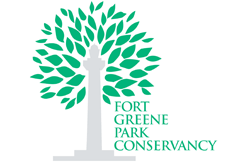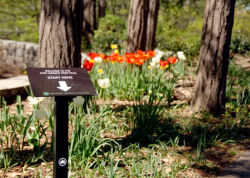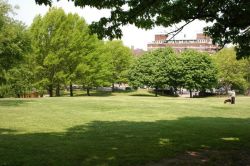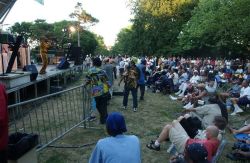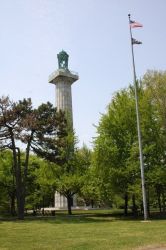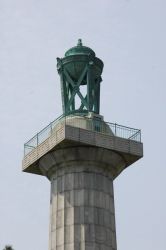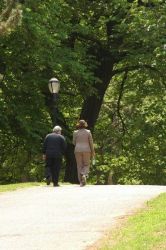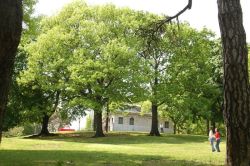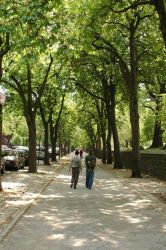Fort Greene Park
View all monuments in NYC Parks, as well as temporary public art installations on our NYC Public Art Map and Guide.
Prison Ship Martyrs Monument
| Artist: | Adolph Alexander Weinman |
| Dedicated: | November 14, 1908 |
| Location: | Myrtle to Dekalb Avenues, Edwards and Cumberland Streets |
Artwork History
This impressive monument, consisting of a 100-foot-wide granite staircase and a central Doric column 149 feet in height, was designed by renowned architect Stanford White (1853–1906). The monument marks the site of a crypt for more than 11,500 men and women, known as the prison ship martyrs, who were buried in a tomb near the Brooklyn Navy Yard.
In 1776, American Major General Nathanael Greene supervised the construction of Fort Putnam on high ground that is now part of this park. During the Battle of Long Island, the Continental Army surrendered the fort and retreated to Manhattan. The British held thousands of captives on prison ships anchored in Wallabout Bay. Over 11,500 men and women died of overcrowding, contaminated water, starvation, and disease aboard the ships, and their bodies were hastily buried along the shore. These brave patriots represented all thirteen colonies and at least thirteen different nationalities. In 1808, the remains of the prison ship martyrs were buried in a tomb on Jackson Street (now Hudson Avenue), near the Brooklyn Navy Yard.
The Brooklyn fort was renamed for General Greene and rebuilt for the War of 1812. When the threat of war passed, locals enjoyed visiting the grounds of the old fort for recreation and relaxation. The City of Brooklyn designated the site for use as a public park in 1845, and newspaper editor Walt Whitman rallied popular support for the project from the pages of the Brooklyn Daily Eagle. In 1847, the legislature approved an act to secure land for Washington Park on the site of the old fort. The improvements were complete by 1850. In 1867, landscape architects Frederick Law Olmsted and Calvert Vaux, designers of Central and Prospect Parks, were engaged to prepare a new design for Washington Park as well as a new crypt for the remains of the prison ship martyrs.
The remains of the prisoners were moved to the site in 1873 into the newly created 25 by 11 foot brick vault. Twenty-two boxes, containing a mere fraction of total volume of remains, were interred in the vault. Towards the end of the 19th century, a diverse group of interests including the federal government, municipal and state governments, private societies, and donors, began a campaign for a permanent monument to the prison ship martyrs. In 1905, the renowned architectural firm of McKim, Mead and White was hired to design a new entrance to the crypt and a wide granite stairway leading to a plaza on top of the hill. From its center rose a freestanding Doric column crowned by a bronze lantern. President-elect William Howard Taft attended the monument’s dedication in 1908.
Sculptor Adolph Alexander Weinman (1870–1952) created the monument’s bronze pieces—the large urn or decorative lantern (never functioning) as well as four eagles that were mounted to the corner granite posts. n the 1960s, the eagles were removed to storage after being repeatedly vandalized. A tablet over the entrance to tomb, also temporarily removed, was donated by the Tammany Society, and was originally the cornerstone of the Navy Yard vault. An elevator and stairs for the interior were installed in 1937; both were removed in 1948 after the monument was renovated by NYC Parks. In 1970, the elevator pit was filled in.
In 2008, one hundred years after its original dedication, the Prison Ship Martyrs Monument was unveiled after a full restoration. It addressed not only the monument, but also the surrounding plaza and the martyrs’ crypt located at the center of the grand staircase. This project consisted of cleaning and repairing the column and plinth, and the tablet and bronze eagles were restored. Two original eagles and two replicas have been reinstalled at the bases of four fluted shafts at the corners of the plaza (two remaining originals are on view in the Arsenal in Central Park). New architectural lighting was also added to illuminate the plaza and monument at night, highlighting this monument’s majestic splendor for another century.
Artwork Details
| Description: | Doric column surmounted by a bronze urn, on a terrace approached by 100 steps; eagles at corners of terrace; plaque and tablet |
| Architect: | Stanford White |
| Materials: | Bronze, Deer Isle granite |
| Dimensions: | Column H: 114' D: 17'6", Total H: 143' |
| Cast: | 1908 |
Inscription
IN THE NAME OF THE SPIRITS OF THE DEPARTED FREE / SACRED TO THEMEMORY OF THAT PORTION OF AMERICAN SEAMEN, SOLDIERS / ON BOARD THE
PRISON SHIPS OF THE BRITISH DURING THE REVOLUTIONARY / WAR AT THE
WALL ABOUT. THIS IS THE CORNERSTONE OF THE VAULT / WHICH CONTAINS
THEIR RELICS. ERECTED BY THE TAMMANY SOCIETY/OF THE COLUMBIAN
ORDER OF THE CITY OF NEW YORK. THE GROUND FOR / WHICH WAS BESTOWED
BY JOHN JACKSON, NASSAU ISLAND, SEASON OF/BLOSSOMS, YEAR OF
DISCOVERY, THE 316TH. OF THE INSTITUTION THE 19TH AND OF AMERICAN
INDEPENDENCE THE 32ND, APRIL THE 6TH, 1808./
JACOB VANDERVOORT / JOHN JACKSON / BURDET STRYKER / ISAACHER
COZZENS / ROBERT TOWNSEND / BENJAMIN WATSON / SAMUEL COWDRY / WILLIAM
AND DAVID CAMPBELL - BUILDER WALL ABOUT COMMITTEE/
TABLET OVER ENTRANCE TO TOMB. ORIGINALLY CORNERSTONE OF A VAULT
IN NAVY YARD, CONTAINING BONES OF 11,000 PATRIOTS. ERECTED IN
NAVY YARD BY TAMMANY SOCIETY.
FORT GREENE PARK OPENED 1849 THROUGH EFFORTS OF WALT WHITMAN,
EDITOR OF BROOKLYN EAGLE. ORIGINALLY CALLED RAYMOND PARK.
Please note, the NAME field includes a primary designation as well as alternate namingsoften in common or popular usage. The DEDICATED field refers to the most recent dedication, most often, butnot necessarily the original dedication date. If the monument did not have a formal dedication, the yearlisted reflects the date of installation.
For more information, please contact Art & Antiquities at (212) 360-8163.
Check out your park's Vital Signs
Clean & Safe
Green & Resilient
Empowered & Engaged Users
Share your feedback or learn more about how this park is part of a
Vital Park System
Contacts
Director of Fort Greene Park: (718) 722-3218






